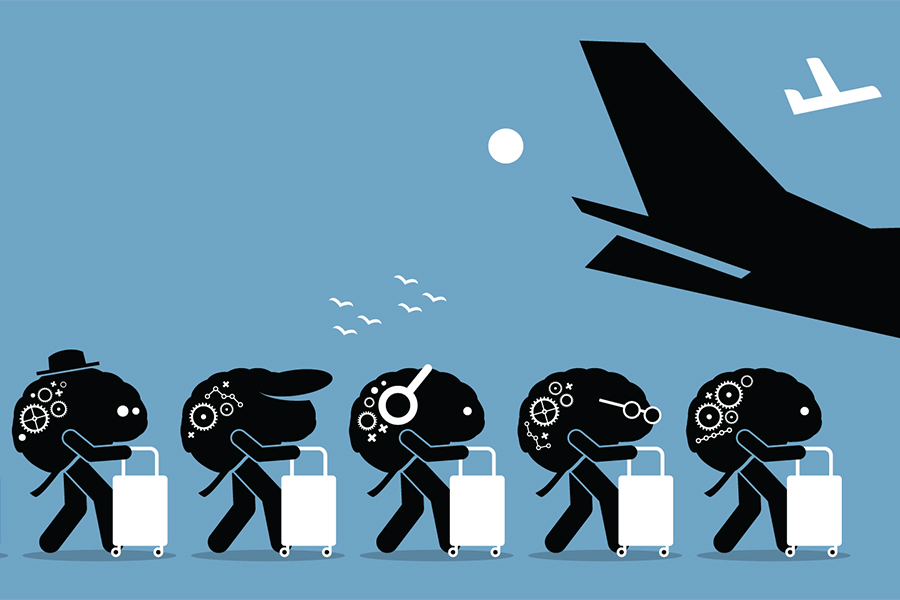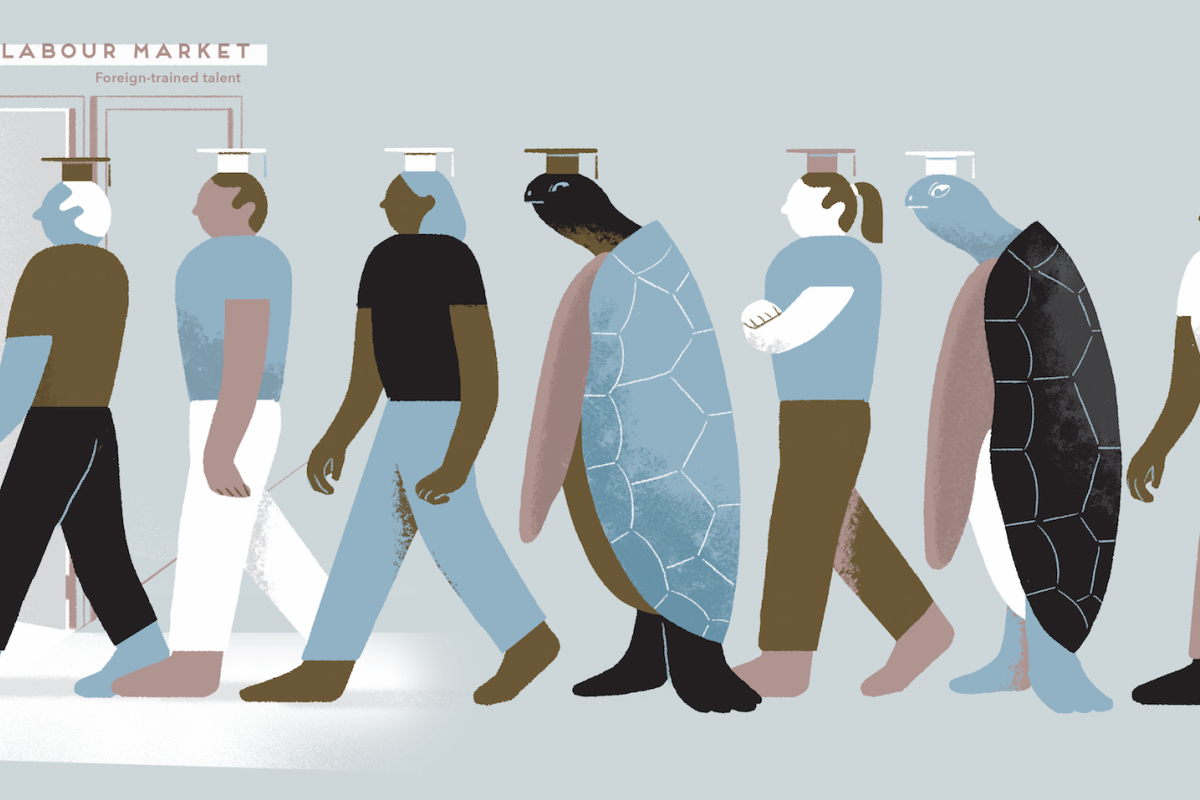
In our current era, more countries are entering stages of industrialization and development to compete with already developed countries. This process of development has many growing pains, some of which can hinder or discourage continued progress and can cause problems that lower rather than raise the standard of living and life expectancy.
One of the more prominent growing pains is brain drain: a process by which the growing educated elite of a region or country emigrate to typically more-developed countries with better opportunities, thus removing the skilled labor workforce from the country’s population.
This reduction in the skilled labor population often translates to a vacuum in necessary services required for development, including education, healthcare, and engineering, among others. This can ultimately decelerate or even stagnate growth. If left unaddressed, brain drain can compound and lead to worse problems.
When a portion of the educated elite leave, there is a higher stress on the remaining skilled workforce to fulfill the demands in services those emigrants were meant to fill. This worsens working conditions and increases the disparity between the actual value of the service provided and the compensation service-providers are ultimately given. These problems then push more of the workforce to emigrate elsewhere, accelerating the rate of brain drain.
This is the case in Nigeria, where improved education has created a swathe of healthcare professionals ready to enter the workforce. In recent years, however, a majority of this workforce has left for developed countries such as Canada, Australia, and the U.S. after completing their education. Of the 72,000 doctors and dentists registered under the Medical and Dental Council of Nigeria, over half of them work outside of the country. This has left the medical industry with one doctor for every 5,000 Nigerians.
Why are Nigerian’s health professionals leaving?
Many health professionals cite a lack of resources—including basic utilities such as water and power— poor working conditions, and poor compensation. They criticize the Nigerian government for allocating only 4 percent of their national budget to healthcare despite the desperate need for such services.

This is despite the fact that, according to Onwufor Uche, consultant and director of the Gynae Care Research and Cancer Foundation in Abuja, “eight of 10 Nigerians are presently receiving substandard or no medical care at all”.
Doctors themselves are payed N200,000 monthly ($560)—a paltry sum compared to the compensation in Canada. With more doctors leaving, the disparity of how much value doctors bring to the economy versus how much they are compensated becomes even greater.
The government of Nigeria has attempted to remedy this situation by providing education subsidies to generate more health professionals. This naturally creates an incentive for more to enter the healthcare industry, but it doesn’t exactly address why people emigrate in the first place.

It is not as if Nigeria’s economy is struggling to generate the funds necessary for a proper compensation program either. As an OPEC country, Nigeria’s profits from petroleum have boomed since the 1970s. Yet, governmental corruption has failed to allocate and invest those economic resources into infrastructure, basic utilities, and key service industries such as healthcare. Many also cite that, while education may be sufficient in creating a healthcare workforce, getting residency and certification from the government is such a grueling process that lead many to either give up or move abroad.
How do we tackle the core issues that lead to brain drain?
Taking on the process of developing infrastructure and industry is a big task– one that is often not done on the government’s participation alone.
Several decades ago, China was in a similar situation as Nigeria is currently. Despite its burgeoning population and the leading regime’s incentives and directives to increase industry in the form of factories, China saw its educated elite fleeing for other developed countries. This was in part due to the oppressive measures in censorship by the government that discriminated against the educated in China.
This discrimination hindered the education system and the emergence of entrepreneurial exploits, particularly in the STEM field. Frustrated by the blocks and the lack of support, particularly during the technology boom of the 1990s, many left China for the U.S. and Japan to participate in the research and development opportunities there.
As China began to experience the effects of this exodus in the stagnation of its industries, particularly in competing in the technology landscape, the Chinese government decided to use the opportunities abroad as leverage. They began a subsidy program which would help Chinese nationals study abroad. Over the next ten years, they focused on generating capital through their exploits in industry and exports. In the early 2000s, the government created economic opportunities competitive to those in other developed countries to entice Chinese nationals back. They specifically targeted sectors they wanted to stimulate, such as solar power.
The number of returning nationals shot up from 1 million in 2001 to 4.8 million in 2017. Chinese nationals who went through this program were dubbed “sea turtles”, as they would bring innovation and education from other sources to enrich China’s economy.

Now, however, some ‘sea turtles’ are struggling to compete with China’s own locally educated youth. Research innovation and infrastructure were built up in such a way that have since made them also educationally competitive on the global stage. Perhaps it is in these conditions that China is can be considered a “developed” nation.
What if developing countries have not acquired enough capital to offer such competitive opportunities?
The development process for a country’s economy may take years, and the effects of brain drain slowing that process only further drains resources (including capital) and time.
The mass emigration of the Filipino workforce, particularly in the nursing and hospitality sector, is a case in which the country of origin simply does not have the resources necessary to remain competitive enough to retain their skilled population. In 2013, the Philippines deployed approximately 1.8 million workers– about 10 percent of its population— to other countries. In that sam year, the country itself was ranked number one for exporting nurses and number two for sending doctors overseas.

Such high statistics are a result of poor working conditions juxtaposed with a remarkably strong nursing and healthcare service education system. Essentially, the Philippines is an example of the extreme implementation of Nigeria’s current plan.
Healthcare in the Philippines continues to suffer the same problems as that in Nigeria– where there is a deficit of healthcare workers for Filipino citizens and infrastructure is still poor. The government attempted to counter such issues by “overproducing” skilled professionals through its highly specialized nursing and healthcare programs.
The large population of abroad workers, however, also has made the remittances those workers significant enough to contribute to the economic growth of the country– up to $25 billion annually. This contribution has led the Filipino government to further encourage migration. This is in part due to the fact that remittances is a steady income that is often unaffected by the regional economic fluctuations. Despite how beneficial remittances have proved for the Filipino economy, there are concerns about the dependency these transactions bring to the country as a whole.
As a means to combat that potential risk, the Filipino government is looking to begin return programs much like China’s “sea turtles,” but face little progress due to the fact that their resources and compensation remain noncompetitive and unstable compared to opportunities abroad. Whilhe the Philippines may still suffer through the growing pains of economic development, they have crafted a way to utilize its brain drain to boost economic development and mitigate the process’ larger problems. This ultimately can encourage its continued development and the aspiration towards a better standard of living.
While these strategies may have worked for China and the Philippines, it is unwise to assume that they will be the save-all for Nigeria. By looking at these examples, however, we can begin to gauge how governmental powers may target one aspect of infrastructure or policy to lower the barrier and reduce push factors.